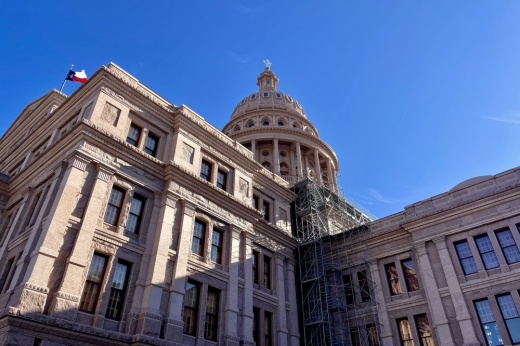The capitol is made of sunset red granite, which comes from Granite Mountain in nearby Marble Falls. When the small, original capitol caught fire in 1881, a team of contractors, led by Detroit architect Elijah E. Myers, was already working on the plans for a new statehouse.
Contractors originally planned to use creamy white limestone from Convict Hill in South Austin, but found it oxidized when exposed to the air, resulting in discoloration, according to the Texas State Preservation Board. The owners of Granite Mountain—George W. Lacy, William H. Westfall and Nimrod L. Norton—agreed to donate enough sunset red granite to build the capitol, as long as the state constructed a railroad to transport the stone and provided labor to quarry it.
Local inmates and workers from Scotland transported over 188,000 cubic feet of granite from Granite Mountain, according to the SPB and the Texas State Historical Association.
Sunset red granite was used to build the Galveston Seawall and other state office buildings near the capitol. The stone is shipped throughout the U.S. and to other countries for use in monuments, buildings and more, according to a historical marker on Granite Mountain.
A storied history
The first cornerstone in the construction of the capitol was laid in 1885. The building was completed three years later.
Atop the capitol is the Goddess of Liberty. The nearly 16-foot-tall statue was likely modeled after Pallas Athena, the Greek goddess of wisdom, justice, and arts and crafts, according to Ali James, curator of the capitol and director of visitor services.
The statue weighs approximately 2,000 pounds, James said, and is made out of zinc, which was covered with white paint and sand to emulate stone.
In 1983, workers discovered cracking, corrosion and missing pieces on the almost century-old goddess, due to impurities in the zinc and natural deterioration from weather. According to the SPB, an aluminum replica of the statue was created in 1986.
The original statue, which has been restored, is displayed at the Bullock Texas State History Museum in Austin, while the goddess’ hand and star are housed at the Capitol Visitors Center.
A fire broke out on the east side of the capitol on Feb. 6, 1983. According to James, a fire marshal at the time said if the building had burned for 15 more minutes, the entire capitol would have been lost.
During the 68th Texas Legislature, lawmakers created the SPB, which was tasked with restoring, preserving and maintaining the capitol and its grounds.
To help with overcrowding, contractors built the four-story Capitol Extension, which is almost entirely underground. The 667,000-square-foot space opened in 1993, and includes offices, conference rooms, committee rooms, an auditorium, a dining room and two levels of parking.
“It really provided a great deal of additional space, because, as you can imagine, Texas and Texas government has grown exponentially since the capitol was completed in 1888,” James said.
Restoration of the main capitol building was completed in 1995, but James said smaller projects have been conducted since then. The SPB is starting a major roof restoration project.
The Texas Capitol is 14.64 feet taller than the U.S. Capitol, according to the SPB. The nation’s capitol is 288 feet tall, while the Texas Capitol stands at 302.64 feet tall from ground level to the tip of the Goddess of Liberty’s star.
Visiting the capitol
Over 1 million people visit the capitol in a typical year, James said. Due to the coronavirus pandemic, the building closed in March 2020 and did not reopen until January 2021, just in time for the 87th legislative session.
One year later, James said the capitol still receives fewer visitors than prepandemic levels, but numbers are rising.
A large portion of the state’s art collection is displayed in the capitol for public viewing. Historic furnishings, such as desks, benches and tables, are shown throughout the building, including in the House and Senate chambers.
The capitol is open 360 days of the year. During the biennial legislative sessions, visitors are allowed to watch the proceedings from the third-floor galleries above the Senate and House chambers. The 88th Texas Legislature began on Jan. 10.
“I would always want to encourage folks who are Texans or who got here as soon as they could to come on down to the capitol and see the Legislature in action,” James said. “... It's always very interesting to be able to see your legislators doing the work of Texans.”
Guided tours are available every day the capitol is open, from 9:30 a.m.-4 p.m. on Monday-Friday and 12:30-4 p.m. on Saturday-Sunday. Visitors can also take self-guided tours using brochures provided by the SPB.





